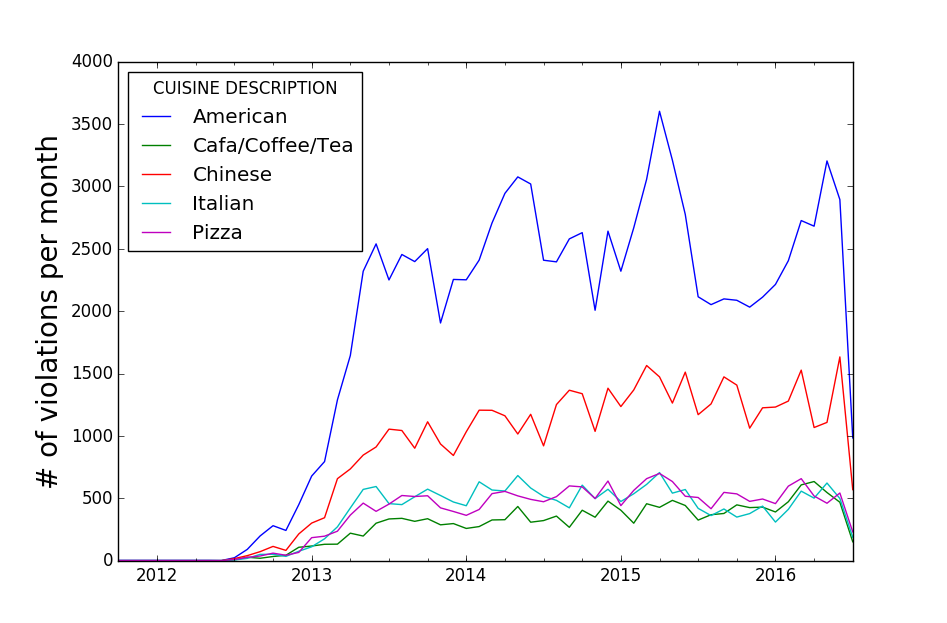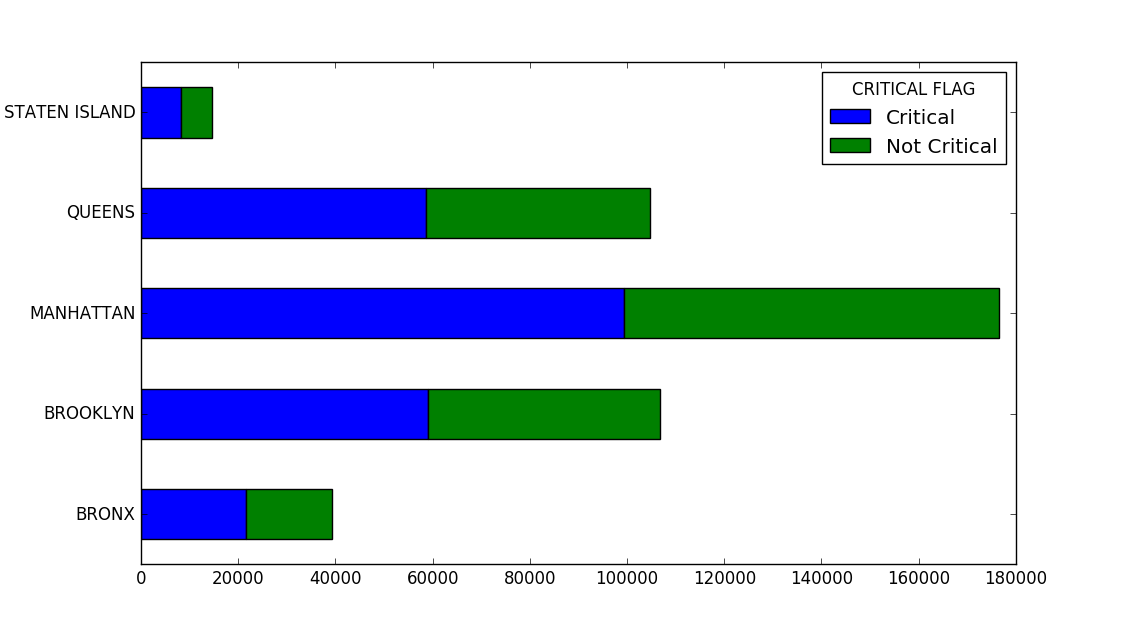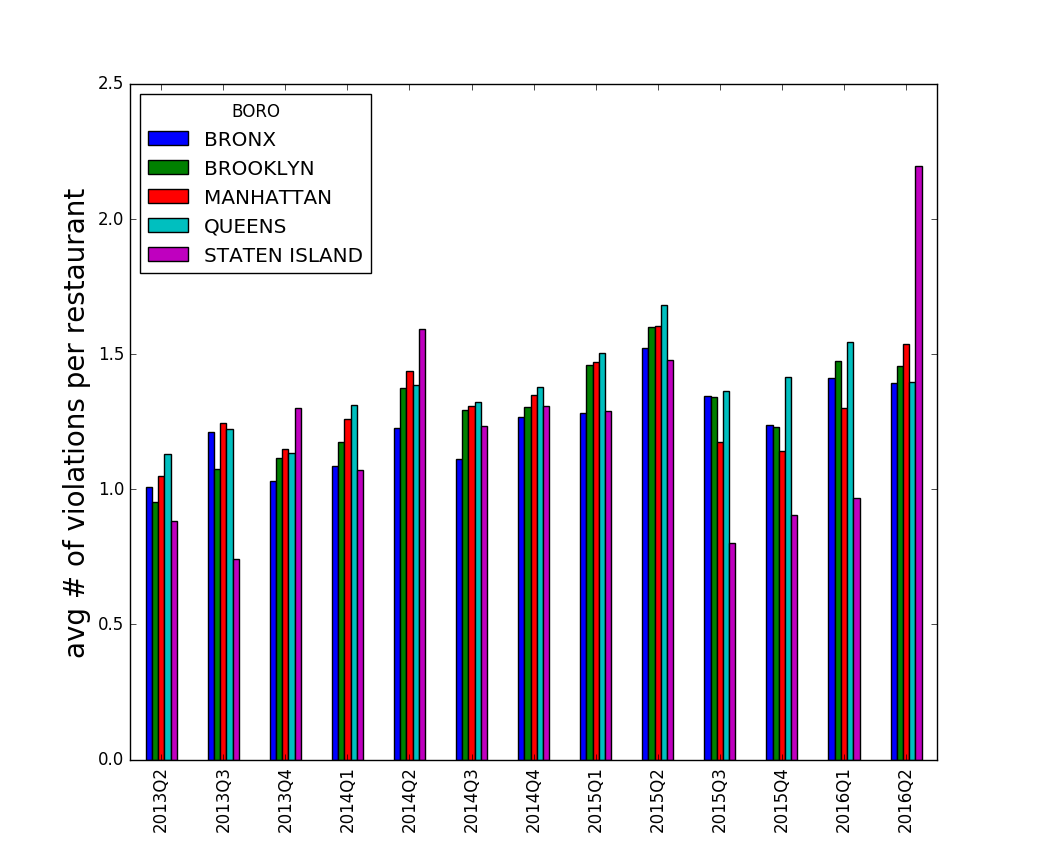DOHMH New York City Restaurant Inspection Results
introduction
The Department of Information Technology and Telecommunications of New York city (NYC DoITT) releases many data sets online for public use. An interesting one is about restaurant hygiene inspection results. It’s quite heart-breaking to check my favorite restaurants there.
In this post, I will pull out some information from it, such as the popular cuisines in the city, worst restaurants for the top cuisine types, etc.
The data can be accessed via the following links. As of Jul 18 2016, the csv file is about 160 MB.
The data can be loaded into pandas DataFrame with the following code.
filename = 'data/DOHMH_New_York_City_Restaurant_Inspection_Results.csv'
df = pd.read_csv(filename,encoding='windows-1252')
df = df[df["INSPECTION DATE"]!='01/01/1900']
df.info(null_counts=True)
I tried a few encoding schemes for pd.read_csv,
but there are still invalid characters in the data. For example,
characters with French accents are not decoded correctly.
Please let me know if you know how to fix it. Thanks.
Anomalies with strange inspection date (01/01/1900) are eliminated. We see then that this data set contains all inspection results from 07/26/2011 to 07/17/2016.
The info function provides the following result.
<class 'pandas.core.frame.DataFrame'>
Int64Index: 449573 entries, 0 to 450712 Data columns (total 18 columns):
CAMIS 449573 non-null int64
DBA 449573 non-null object
BORO 449573 non-null object
BUILDING 449455 non-null object
STREET 449573 non-null object
ZIPCODE 449573 non-null int64
PHONE 449556 non-null object
CUISINE DESCRIPTION 449573 non-null object
INSPECTION DATE 449573 non-null object
ACTION 449573 non-null object
VIOLATION CODE 442160 non-null object
VIOLATION DESCRIPTION 441936 non-null object
CRITICAL FLAG 449573 non-null object
SCORE 421074 non-null float64
GRADE 212342 non-null object
GRADE DATE 210769 non-null object
RECORD DATE 449573 non-null object
INSPECTION TYPE 449573 non-null object
dtypes: float64(1), int64(2), object(15)
memory usage: 65.2+ MB
Here the field CAMIS is the unique identifier for the restaurant,
DBA is the name of the restaurant, and CRITICAL FLAG is the
result of the inspection.
There are many repeated names in DBA, since many restaurants have multiple
sites.
There are three possible inspection results in CRITICAL FLAG.
Not Applicable means nothing wrong was found.
Critical means some serious issue was found, such as mice,
flies, raw/cooked food adulterated, etc.
Not Critical refers to issues such as improper plumbing,
improper non-food contact surface, facility not vermin proof, etc.
Further details of the violation can be seen in the VIOLATION CODE and
the VIOLATION DESCRIPTION fields.
CRITICAL FLAG
Critical 246880
Not Applicable 7637
Not Critical 195056
Looking at the inspection results, it seems the hygiene of the whole industry is in jeopardy.
the popular cuisines
In this section, I will examine the most popular cuisine in NYC based on the number of restaurants out there. Specifically, the following information will be extracted.
- top 5 popular cuisines and the corresponding restaurant numbers
- total number and average number of hygiene violations by cuisine types
- worst 5 restaurants for each cuisine type
- time evolution of the monthly violations for each cuisine type
To find out the most popular cuisine types, we can use the following code
by_cuisine = df[['CAMIS', 'CUISINE DESCRIPTION']] \
.drop_duplicates(['CAMIS'])
.groupby(['CUISINE DESCRIPTION'])
top5 = by_cuisine.size().sort_values(ascending=False)[:5]
Since each row in the DataFrame is an inspection and a restaurant can be inspected multiple times,
we need to count each restaurant only once by drop_duplicates(['CAMIS']).
We then extract all the hygiene violations for the top 5 cuisines using the following code
cuisines = top5.index.values
viols = df[df['CRITICAL FLAG']!='Not Applicable']
mask = viols['CUISINE DESCRIPTION'].isin(cuisines)
top_cuisines = viols[mask][['DBA', 'CAMIS','CUISINE DESCRIPTION', 'INSPECTION DATE']]
by_cuisine = top_cuisines.groupby(['CUISINE DESCRIPTION'])
v_counts = by_cuisine.size()
cuisine_facts = pd.concat([top5, v_counts],axis=1)
cuisine_facts.sort_values(by=0, inplace=True, ascending=False)
cuisine_facts[2] = (v_counts / top5).apply(lambda x: '%.0f' %x)
cuisine_facts.rename(columns={0:'# of restaurants',
1:'# of violations',
2:'avg violations'})
In the above code, we first save all hygiene violations in viols.
Using the groupby() function, we save the total number of violations for the top 5 cuisine
types in v_counts.
Then we combine the two Series top5 and v_counts with pandas.concat().
Some basic facts about the top 5 cuisines sorted by number of restaurants are as follows. To my surprise, there are a lot more American restaurants than other cuisine types. In terms of average violations per restaurant, Cafe/Coffee/Tea shops have significantly less violations.
# of restaurants # of violations avg violations
American 6034 102612 17
Chinese 2395 48728 20
Cafe/Coffee/Tea 1391 15493 11
Pizza 1172 21034 18
Italian 1031 20795 20
I also want to know the worst restaurants, i.e., the ones with most violations. Using the following code, you can see the five restaurants with most number of hygiene violations, for each cuisine type.
name_map = top_cuisines[['DBA','CAMIS']].drop_duplicates()
worst_by_cuisine = top_cuisines.groupby('CUISINE DESCRIPTION') \
.CAMIS.value_counts().groupby(level=0).head(5)\
.reset_index(name='# of violations')
worst_by_cuisine = pd.merge(worst_by_cuisine, name_map, on='CAMIS') \
.set_index(['CUISINE DESCRIPTION','CAMIS'])
The result is as follows. Fortunately, I haven’t been to many of them. You can see the worst Chinese restaurants are the worst of the worsts.
# of violations DBA
CUISINE DESCRIPTION CAMIS
American 40916695 88 KEY CLUB
41709379 70 LONE STAR BAR & GRILL
41706342 69 ROCKAWAY CAFE
50000543 69 BLACK TREE
41164678 68 NIOS RESTAURANT
Cafe/Coffee/Tea 41640196 63 CHECKPOINT BEN CAFE
41706722 56 EUROPEAN CAFE
41161594 50 SMOOCH
41458679 46 ALEEF COFFEE HOUSE
41598755 45 TROOST
Chinese 41289382 95 JADE ASIAN RESTAURANT
41586091 94 FENG CHENG YUAN RESTAURANT
41683816 89 MAX BAKERY & RESTAURANT
41602559 86 RED CHOPSTICK
41539257 76 FOO KEE SEAFOOD RESTAURANT
Italian 40745126 68 PINOCCHIO RISTORANTE
40725591 63 TWO BOOTS
41563537 60 BENITO ONE
41406564 59 KEN & COOK
41551620 59 VAPIANO
Pizza 40743368 82 DOMINO'S
40580547 64 KNAPP ST PIZZA
50001396 63 PIZZA PLUS
40604769 58 FAMOUS FAMIGLIA
41705032 58 GRANDMAS ORIGINAL PIZZA
I also plot the time evolution of the hygiene violations for the
popular cuisines. The code is as follows.
The INSPECTION DATE field contains string like '07/18/2013'.
They are converted to pandas time series index.
top_cuisines.index = pd.to_datetime(top_cuisines['INSPECTION DATE'].values)
ts_cuisine = top_cuisines.groupby([top_cuisines.index.to_period('m'),
top_cuisines['CUISINE DESCRIPTION']]) \
.size().unstack().fillna(0)
ts_cuisine.plot()
plt.ylabel('# of violations', fontsize=20)
plt.savefig('violation_by_cuisine_ts.svg', bbox_inches='tight')
And the result can be seen below.
It seems the American restaurants have poor performance in spring
time while the other cuisines have more consistent performance
over the year.

the boros
In this section, I will look into the hygiene violations in different boros. Specifically,
- most popular cuisine type in each boro and their average number of violations
- violation distribution among the five boros
- time evolution of the average number of violations in each boro
Firstly, I would like to know what are the most popular restaurants in each boro. The following code calculates the top five cuisines by number of restaurants in each boro.
vBORO = viols[viols['BORO']!='Missing'][['BORO','CRITICAL FLAG', 'INSPECTION DATE', 'CUISINE DESCRIPTION','CAMIS']]
vBORO = vBORO[vBORO['BORO']!='Missing']
cuisine_by_boros = vBORO.groupby('BORO')['CUISINE DESCRIPTION'] \
.value_counts().groupby(level=0).head(5) \
.reset_index(name='# of restaurants')
cuisine_by_boros.set_index(['BORO','CUISINE DESCRIPTION'],inplace=True)
Then I count the number of violations for each cuisine type in each boro, concatenate it with the number of restaurants, and then calculate the average number of hygiene violations for each cuisine type.
v_by_boro_cuisine = vBORO.groupby('BORO')['CUISINE DESCRIPTION'].value_counts()
result = pd.concat([cuisine_by_boros, v_by_boro_cuisine], axis=1, join='inner')
result[0] = (result[0] / result['# of restaurants']).apply(lambda x: '%.0f' %x)
result.rename(columns={0:'avg violations'}, inplace=True)
The result is as follows. In all five boros except Manhattan, American restaurants and Chinese restaurants are the most popular base on number of establishments. In Manhattan, however, Cafe/Coffee/Tea shops take the second place. Maybe it’s related to tourism. The tourists might prefer to grab something simple to save money and time.
# of restaurants avg violations
BORO CUISINE DESCRIPTION
BRONX American 425 15
Chinese 330 17
Pizza 206 17
Latin 182 24
Spanish 128 20
BROOKLYN American 1254 17
Chinese 750 20
Cafe/Coffee/Tea 350 12
Caribbean 320 21
Pizza 306 18
MANHATTAN American 3066 18
Cafe/Coffee/Tea 757 11
Italian 596 21
Chinese 490 25
Japanese 459 21
QUEENS American 1026 17
Chinese 738 20
Latin 322 24
Pizza 271 18
Cafe/Coffee/Tea 212 11
STATEN ISLAND American 222 17
Chinese 81 17
Italian 72 18
Pizza/Italian 59 20
Pizza 53 19
Then let’s check how many violations do each boro have in total.
by_boro = vBORO.groupby(['BORO','CRITICAL FLAG'])
flag_by_boro = by_boro.size().unstack()
flag_by_boro.plot(kind='barh',stacked=True)
The result is shown below. It seems that for all boros there are more critical violations than minor ones.

The quarterly violations per restaurant in each boro is shown as follows. Data before the second quarter in 2013 are omitted due to their small sample size. There are a few trends over the years
- Bronx, Brooklyn, Manhattan and Queens have similar performance
- Usually, Staten island has better performance
- Staten island had significantly worse performance in the last quarter

summary
This is a very preliminary exploration of this dataset. I intended to polish my pandas skills with it.
There are interesting projects one can do with this dataset. For example, there was a competition at DrivenData where the data scientist attempted to use Yelp data to predict the restaurant inspection data. See the link below if you are interested.


